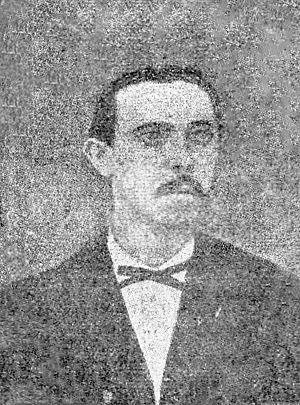Severino Albarracín facts for kids
Severino Albarracín Broseta (1851–1878) was an important Spanish leader who believed in a type of political idea called anarchism. He was trained as a teacher. Severino became a key person in a group called the Spanish Regional Federation, which was part of the First International. He played a big role in a major workers' strike in 1873, known as the Petroleum Revolution, in a city called Alcoy.
Later, he had to leave Spain and live in Switzerland. There, he joined another group called the Jura Federation. Even while working, he continued to support ideas of social change through uprisings. After some years, he came back to Spain. Sadly, he passed away from a lung illness called tuberculosis.
Quick facts for kids
Severino Albarracín
|
|
|---|---|
 |
|
| Born | 1851 Llíria |
| Died | February 5, 1878 (aged 26–27) Barcelona |
Contents
Early Life and Education
Severino Albarracín Broseta was born in 1851 in Llíria, a town close to Valencia, Spain. When he was young, after a big change in government called the Glorious Revolution in 1868, Severino joined a youth group in Valencia. This group was interested in new political ideas.
He studied at the Valencia Normal School and became a teacher. This was an important step for him.
Joining the First International
Around 1871, Severino Albarracín became very interested in a large international group called the First International. This group aimed to unite workers from different countries. He also joined a specific part of it called Bakunin's International Alliance of Socialist Democracy.
Severino was an anarchist, meaning he believed in a society without a government or rulers. He became a representative for the Spanish Regional Federation at a big meeting in Zaragoza in 1872.
In the same year, he was chosen to be part of the Regional Federation's main council. Later, he became its secretary, working from the city of Alcoy. He also attended another important meeting in Córdoba in 1873.
The Petroleum Revolution
By 1873, Severino believed in making big social changes through local uprisings. He was a key person in a large workers' strike in Alcoy in July 1873. This event was called the Petroleum Revolution.
During this time, Severino and other members of the International demanded that the mayor of Alcoy give power to a new group that supported the revolution.
He was arrested because of his involvement in this uprising. The next year, he was arrested again for writing a statement for the First International. He even used a false name to try and avoid being caught. After he was released, he quickly left Spain and went to Switzerland.
Life in Exile
In Switzerland, Severino joined the Jura Federation, another group that shared similar ideas. While in exile, he met other important thinkers like Peter Kropotkin, James Guillaume, and Paul Brousse.
Severino continued to believe in social change through uprisings. He was part of the most radical group within the Spanish Regional Federation. He worked in a cooperative that made engravings in a town called Le Locle. Later, he worked for Abraham Dargère, who was involved in the Paris Commune.
He was supposed to be a Spanish representative at a meeting in Bern in 1876, but he didn't go. That same year, using the name Gabriel Albagès, he was chosen twice for the International's federal council. However, he decided to step down to work as a painter and plasterer in La Chaux-de-Fonds.
Return to Spain and Final Years
After trying to translate a book by Guillaume into Spanish and not finding other work, Severino Albarracín returned to Spain in 1877. He continued his activism in Barcelona and kept in touch with Kropotkin through letters.
Severino passed away in Barcelona on February 5, 1878. He was only 26 or 27 years old. His death was caused by tuberculosis, a serious lung disease.
Today, a street in Alcoy is named in his honor.
See also
 In Spanish: Severino Albarracín para niños
In Spanish: Severino Albarracín para niños

